The M7 By The Numbers: What It Takes To Get In & What It Means For Your Career
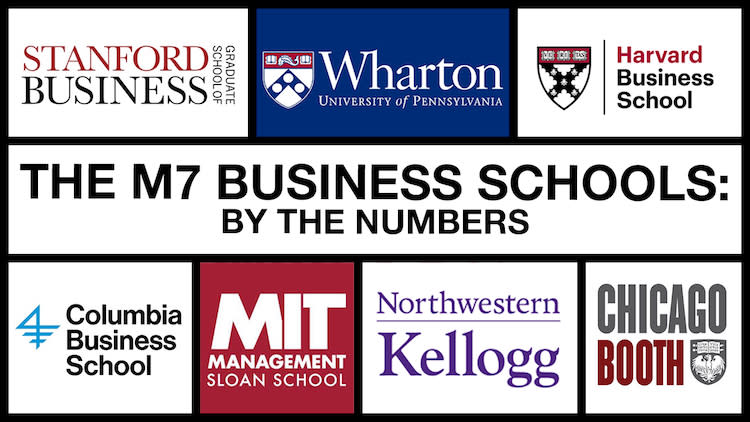
In the 2021-2022 MBA application cycle, only around 7,700 out of more than 40,000 applicants earned admission to an MBA program at one of the vaunted M7 business schools. About 4,700 enrolled that fall. That’s a 20.3% acceptance rate and a 60.3% yield.
A year later, in 2022-2023, applicants to the M7 dropped by about 500, while admits grew to more than 8,000 — increasing the collective acceptance rate at Harvard Business School, the Wharton School at the University of Pennsylvania, Stanford Graduate School of Business, Columbia Business School, MIT Sloan School of Management, Northwestern Kellogg School of Management, and Chicago Booth School of Business to 21.8%. In two short years, the acceptance rate to an M7 had ballooned by more a third, up from an anemic 16.2%. Meanwhile, yield — the percentage of admits who actually enroll — fell at five schools, dropping collectively to 58.8%.
The bottom line: In two short application cycles, M7 acceptance rate jumped 34% and yield dropped 10%. Is this the start of an era of greater accessibility at the most elite business schools in the U.S., which are among the most elite in the world — or the tail end of a short window, of a kind we have seen before? For the time being, it sure looks like the M7 are easier to get into now than they have been for many years.
THE M7 BY THE NUMBERS: 2023 EDITION
2023 Data (2022) | Harvard | Wharton | Columbia | Booth | Kellogg | Stanford | MIT | 2023 Total/Average (2022) |
Class Size | 938 (1,015) | 874 (877) | 829 (844) | 637 (621) | 529 (503) | 431 (424) | 409 (408) | 4,647/663.9 (4,692/670.3) |
Acceptance Rate | 13.2% (14.4%) | 24.8% (22.8%) | 22.4% (19.7%) | 32.6% (30.1%) | 33.3% (31.4%) | 8.4% (8.6%) | 17.8% (14.8%) | 21.8% (20.3%) |
Admits | 1,076 (1,187) | 1,533 (1,442) | 1,215 (1,109) | 1,364 (1,308) | 1,439 (1,316) | 521 (528) | 947 (792) | 8,095/1,156.4 (7,682/1,097.4) |
Yield | 87.2% (85.5%) | 57.0% (62.0%) | 56.2% (56.7%) | 48.2% (48.5%) | 36.8% (38.2%) | 82.7% (80.3%) | 43.2% (51.5%) | 58.8% (60.3%) |
Applications | 8,149 (8,264) | 6,193 (6,319) | 5,430 (5,643) | 4,184 (4,352) | 4,316 (4,187) | 6,190 (6,152) | 5,317 (5,349) | 39,779/5,683 (40,266/5,752) |
Average GMAT | *740 (*730) | 728 (733) | 730 (732) | 728 (729) | 731 (729) | 738 (737) | *730 (*730) | 731 – 5 schools (732 – 5 schools) |
Average GPA | 3.73 (3.70) | 3.60 (3.60) | 3.50 (3.60) | 3.60 (3.60) | 3.70 (3.70) | 3.77 (3.76) | *3.61 (*3.62) | 3.65 – 6 schools (3.66 – 6 schools) |
Average GRE | *326 (*326) | 324 (324) | N/A (322) | 325 (327) | *326 (N/A) | 328 (327) | N/A (325) | 325.7 – 3 schools (325 – 5 schools) |
Women | 45% (46%) | 50% (50%) | 44% (44%) | 42% (40%) | 48% (48%) | 46% (44%) | 46% (46%) | 45.9% (45.4%) |
International | 39% (38%) | 31% (35%) | 47% (51%) | 36% (37%) | 39% (38%) | 36% (37%) | 40% (40%) | 38.3% (39.4%) |
US Students of Color | 49% | 41% | 43% | 49% | 42% | 50% | 56% | 47.1% |
Source: M7 business schools and U.S. News
*Median
THE NORTH STAR OF MBA ASPIRANTS
The M7 are seven distinct schools, each with its own area of renown and expertise, and each with its own recent set of challenges. Collectively, they are leaders in gender and racial equity in higher education; magnets for the world’s most talented young leaders; home to the most elite faculty and thought leaders; and sources of the most groundbreaking research and initiatives. They are also vectors of a mind-blowing level of philanthropy, with billions in endowments and large gifts by donors with the world’s deepest pockets. (Among many other things this allows the schools to employ marketing and data collection teams which give them a constant voice in higher education coverage.)
Poets&Quants writes a lot about the so-called Magnificent 7 business schools — see links to past stories below — because of all of the above and for the simple reason that news about these B-schools has always been a big draw. As the vast majority of P&Q‘s readers are prospective MBA students rather than current ones or alumni, the popularity of these stories underscores more than the aspirational appeal of the M7: It also highlights the stability of this self-selected group of schools in a chaotic graduate business education landscape. It should go without saying that getting into an M7 changes someone’s life, almost always for the better.
Change is the only constant in business education. The M7 is the north star of MBA aspirants, existing at a consistent level of superior quality and career assurance. In a world of unknowns, the M7 B-schools are islands of stability — or were, until recently. With MBA applications down globally more than 8% since 2021, the M7 is also the proverbial canary in a coal mine, signaling when the air has gone bad and help is needed.
M7 MBA APPLICATIONS THROUGH THE YEARS
School | 2022-2023 Apps | 2021-2022 Apps | 2020-2021 Apps | 2019-2020 Apps | 2018-2019 Apps | 2017-2018 Apps | 2-Year Application Trend | 6-Year Application Trend |
Harvard | 8,149 | 8,264 | 9,773 | 9,304 | 9,228 | 9,886 | -115 (1.4%) | -1,737 (17.6%) |
UPenn (Wharton) | 6,193 | 6,319 | 7,338 | 7,158 | 5,905 | 6,245 | -126 (2.0%) | -52 (0.8%) |
Columbia | 5,430 | 5,643 | 6,535 | 6,971 | 5,876 | 6,029 | -213 (3.8%) | -599 (9.9%) |
Chicago (Booth) | 4,184 | 4,352 | 5,037 | 4,909 | 4,433 | 4,289 | -168 (3.9%) | -105 (2.4%) |
Northwestern (Kellogg) | 4,316 | 4,187 | 4,632 | 5,813 | 3,779 | 4,471 | +129 (3.1%) | -155 (3.5%) |
Stanford GBS | 6,190 | 6,152 | 7,367 | 7,324 | 7,342 | 7,797 | +38 (0.6%) | -1,607 (20.6%) |
MIT (Sloan) | 5,317 | 5,349 | 7,112 | 6,350 | 5,200 | 5,560 | -32 (0.6%) | -243 (4.4%) |
Source: M7 business schools and U.S. News
MYSTERIOUS ORIGINS
The M7 was created after a legendary meeting of the schools’ deans many years ago, details of which have intentionally been kept mysterious. What emerged is a union that to this day impacts every level of the seven schools and other schools that do business with them — which is most of the world’s top B-schools, and thus the vast majority of the graduate business education universe.
The M7 framework impacts more than the twice-yearly meetings among the seven deans; it also affects meetings among vice deans, admissions directors, career management directors, even PR and marketing types, as well as partnerships and programs between the schools that have created student leaders for decades.
What is new about the M7? For the prospective MBA applicant, the schools release a mountain of data every year that we slice, dice, compare and contrast with previous years; from this, trends emerge that impact the entire graduate business landscape. As we begin a new school year when a flood of Class of 2026 MBA class profile and employment data will imminently be available, we offer this collection of the available numbers from the previous MBA Classes at the M7 — a window into the elite of the elite. Check out these links to our past coverage:
THE M7 B-SCHOOLS: EVERYTHING YOU NEED TO KNOW (2023)
RANKINGS, RATES, ROI & MORE: THE M7 BY THE NUMBERS (2022)
HOW THE M7’S MAGNIFICENCE WAS TESTED IN 2020 (2021)
THE M7: STILL (MOSTLY) THE MOST MAGNIFICENT OF THEM ALL (2020)
NEW M7 DATA, FAMILIAR MAGNIFICENCE (2019)
M7 SCHOOLS: THE 2018 DATA IS IN & THEY REMAIN MAGNIFICENT (2018)
THE M7, ELITE OF THE ELITE, BY THE NUMBERS (2017)
LEADING THE WAY WITH WOMEN
The easiest way to measure the impact of the M7 is through data. Employment data from the M7 MBA Classes of 2023 and profile data from the Classes of 2025 contained in this story, like the data from previous stories and prior classes, are a snapshot of some of the world’s most talented leaders in their incubation. The Class of 2023 data is particularly interesting as a portrait of those who started classes in a pandemic environment, with studies that were conducted partly or entirely online. Compared to their predecessors, what were class GMATs, GREs, and GPAs? What were the levels of women and international students admitted at each school? What industries did they matriculate to, and what did they earn? Here is where you will find the answers.
Let’s talk trends. One historical way in which the M7 have led the world: women. Though it wasn’t an M7 school that finally broke the gender equity barrier by enrolling 50% of women, it was M7 schools leading the way to that threshold — and now, at Wharton for the last three years, maintaining it. Six of the seven have for several years had at least 40% women in their full-time MBA programs; all do now.
The M7 lead by example in racial representation, as well. According to the most recent MBA class profile data, all seven schools have greater than 40% representation of U.S. students of color. They also lead in international composition, with all but one school boasting at least 36% foreign students.
They’re also among the biggest classes, in terms of actual students in classrooms, of any schools in the world. See the numbers in the table above.
MBA CLASS SIZES AT THE M7: CLASSES OF 2022 TO 2025
School | Class of 2025 Enrollment | Class of 2024 Enrollment | Class of 2023 Enrollment | Class of 2022 Enrollment | 2-Year Change | 4-Year Change |
Harvard | 938 | 1,015 | 1,010 | 732 | -77 (7.6%) | +206 (28.1%) |
UPenn (Wharton) | 874 | 877 | 897 | 916 | -3 (0.3%) | -42 (4.6%) |
Columbia | 829 | 844 | 847 | 782 | -15 (1.8%) | +47 (6.0%) |
Chicago (Booth) | 637 | 621 | 620 | 621 | +16 (2.6%) | +16 (2.6%) |
Northwestern (Kellogg) | 529 | 503 | 508 | 559 | +26 (5.2%) | -30 (5.4%) |
Stanford GBS | 431 | 424 | 426 | 436 | +7 (1.7%) | -5 (1.1%) |
MIT (Sloan) | 409 | 408 | 450 | 484 | +1 (0.2%) | -75 (15.5%) |
Source: M7 business schools and U.S. News
THE M7 FACE CHALLENGES, TOO
If it’s reported in class profiles, the M7 probably lead in it:
Graduate Management Admission Test scores: All the M7 schools are at or near 730 in average or median, and Stanford GSB led all schools in 2022 with a 738 class average;
Graduate Record Exam scores: Of the schools that report this data, all are above 324 cumulative scores; very few other schools in the U.S. top 50 can say the same;
Undergraduate GPA: All but one of the schools boast class averages of 3.60 or greater (led once again by Stanford at 3.77).
The M7 have their challenges, of course. They are not immune to larger forces bearing down on graduate business education, a fact reflected in application volume to their MBA programs: All seven saw drops in apps between 2021 and 2022, and five saw drops again between 2022 and 2023; all have seen declines in the six years since the 2017-2018 application cycle. As apps have declined, so have class sizes overall, even as four of the seven schools reported year-over-year increases in their class sizes in 2023, and three have grown their classes overall in the last four years.
A particular sore spot has been job placement, and a particularly thorny industry has been tech. Where the M7 led the way to high MBA employment in tech two decades ago, they now are struggling along with the rest of graduate business education to place their grads in a beleaguered industry. The M7 are particularly vulnerable because so many people with the right profile to gain admission at a top schools have finance and tech backgrounds; with both industries suffering, it’s safer for these candidates to stay in their jobs and wait for more favorable conditions rather than take the risk of whiffing in post-MBA recruiting. See the table below for what that vicious cycle looks like in tech placement at the M7.
M7 TECH PLACEMENT 2019-2023
School | MBA Class of 2023 Tech Placement | MBA Class of 2022 | MBA Class of 2021 | MBA Class of 2020 | MBA Class of 2019 |
Harvard | 16.0% | 19.0% | 19.0% | 19.0% | 20.0% |
Wharton | 13.5% | 19.4% | 17.4% | 16.9% | 16.2% |
Columbia | 10.8% | 16.0% | 17.0% | 19.8% | 13.8% |
Chicago Booth | 15.5% | 14.9% | 14.9% | 16.3% | 20.7% |
Kellogg | 17.0% | 21.0% | 26.0% | 25.0% | 23.0% |
Stanford | 24.0% | 30.0% | 29.0% | 28.0% | 24.0% |
MIT Sloan | 24.1% | 22.6% | 25.0% | 27.6% | 30.7% |
Source: School employment reports
The challenges faced by the M7 are to greater or lesser degree faced by B-schools everywhere. How the M7 overcome them will, as always, serve as an example for other schools to follow.
See the next page for breakdowns on tuition and cost, MBA pay and placement, and industry choices for M7 grads.
LEARN MORE ABOUT THE M7 AND OTHER TOP B-SCHOOLS:
ACCEPTANCE RATES, APPLICATIONS, ADMITS, YIELDS & MORE AT THE TOP 100 U.S. B-SCHOOLS
HIGH & LOW GMAT SCORES AT THE WORLD’S LEADING MBA PROGRAMS
GRE SCORE AVERAGES AT THE TOP 50 U.S. MBA PROGRAMS
UNDERGRADUATE GPA: WHAT IT TAKES TO GET INTO A TOP-50 U.S. MBA PROGRAM
WOMEN AT THE LEDING U.S. & GLOBAL MBA PROGRAMS
THE U.S. MBA PROGRAMS WITH THE MOST INTERNATIONAL STUDENTS
MINORITIES AT THE LEADING U.S. MBA PROGRAMS
AND VISIT POETS&QUANTS’ M7 SCHOOL PROFILE PAGES:
THE WHARTON SCHOOL AT THE UNIVERSITY OF PENNSYLVANIA
CHICAGO BOOTH SCHOOL OF BUSINESS
NORTHWESTERN KELLOGG SCHOOL OF MANAGEMENT
STANFORD GRADUATE SCHOOL OF BUSINESS
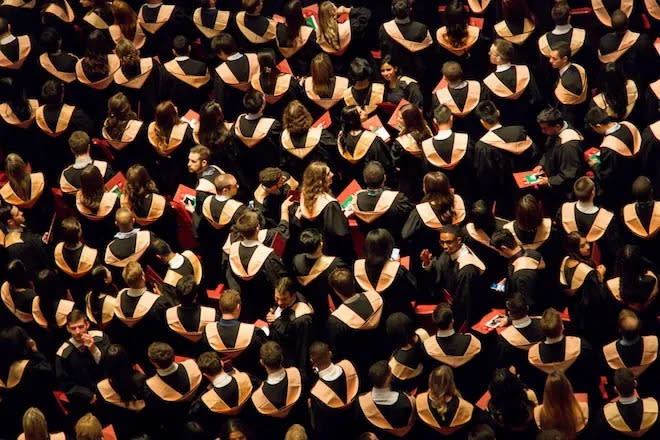
Four years ago, only two of the seven schools in the M7 had 40% or greater female enrollment. Now all seven do
Cost is a major structural barrier to joining the M7 — just as it is to building board rooms, management teams, and workforces that better resemble the societies in which they operate. The M7 solution to the exorbitant cost of attendance has been to offer an increasing number of scholarships and greater accessibility to underrepresented groups. In 2022, Harvard Business school announced plans to cover tuition and fees for 10% of its admits based on need; this was in the midst of a five-year span in which HBS resolutely maintained a flat tuition rate, only breaking that streak for those entering in fall 2023.
Likewise, Columbia kept its tuition stable for three straight admission cycles. Stanford and Harvard offer average annual awards of between $44,000 and $46,000 that are received by half the respective MBA programs’ students. Kellogg has boasted that nearly two-thirds qualify for and receive financial aid.
But the fact remains: The M7 are not just the most illustrious of the world’s business schools — they are also the most expensive. Depending on living expenses, which fluctuate significantly according to school location and a student’s family size, two years of a full-time residential program at one of the M7 schools can cost anywhere from a quarter million dollars to well over $300K. The estimated average two-year cost at the M7 in 2024 was $247,550, up from around $241,000 in 2023. See tables below for details.
TUITION AT THE M7: 2023-2024
School | Tuition 2024 | Tuition 2023 | Y-O-Y Change |
Harvard | $ 76,410 | $ 74,910 | $1,500 (2.0%) |
Wharton | $ 84,830 | $ 87,370 | -$2,540 (2.9%) |
Columbia | $ 88,300 | $ 84,496 | $3,804 (4.5%) |
Chicago (Booth) | $ 84,198 | $ 80,961 | $3,237 (4.0%) |
Northwestern (Kellogg) | $ 83,610 | $ 81,015 | $2,595 (3.2%) |
Stanford GBS | $ 82,455 | $ 79,860 | $2,595 (3.2%) |
MIT (Sloan) | $ 86,550 | $ 84,200 | $2,350 (2.8%) |
Source: M7 business schools
TOTAL COST AT THE M7: 2023-2024
School | Total Cost 2024 | Total Cost 2023 | Y-O-Y Change |
Harvard | $ 118,854 | $ 115,638 | $3,216 (2.8%) |
Wharton | $ 127,716 | $ 124,476 | $3,240 (2.6%) |
Columbia | $ 132,258 | $ 127,058 | $5,200 (4.1%) |
Chicago (Booth) | $ 125,937 | $ 122,160 | $3,777 (3.1%) |
Northwestern (Kellogg) | $ 125,191 | $ 120,432 | $4,759 (4.0%) |
Stanford GBS | $ 130,746 | $ 126,465 | $4,281 (3.4%) |
MIT (Sloan) | $ 126,744 | $ 109,180 | $17,564 (16.1%) |
Source: M7 business schools
ESTIMATED 2-YEAR COST AT THE M7: 2023-2024
School | Estimated 2-Year Cost 2024 | Estimated 2-Year Cost 2023 | Y-O-Y Change |
Harvard | $ 234,492 | $ 227,944 | $6,548 (2.9%) |
Wharton | $ 252,192 | $ 243,044 | $9,148 (3.8%) |
Columbia | $ 259,316 | $ 249,518 | $9,798 (3.9%) |
Chicago (Booth) | $ 248,097 | $ 237,622 | $10,475 (4.4%) |
Northwestern (Kellogg) | $ 245,623 | $ 237,691 | $7,932 (3.3%) |
Stanford GBS | $ 257,211 | $ 250,854 | $6,357 (2.5%) |
MIT (Sloan) | $ 235,924 | $ 229,175 | $6,749 (2.9%) |
Source: M7 business schools & P&Q analysis
HURDLES & DARK CLOUDS
If the cost hurdle can be overcome — and the schools collectively offer dozens of fellowships, scholarships and other aid to help make that happen — an MBA from one of the M7 schools is, simply put, a ladder to higher status in society. In 2023, median starting salaries ticked upward at four of the seven schools, remaining flat — but still elite-level high — at the others. Signing bonuses were mostly flat but remain among the highest reported by any MBAs anywhere. Median compensation, calculated using the percentage of those reporting a bonus, grew at four of the seven schools and dropped slightly at two; some of the M7 schools report — and all have grads who receive — other compensation such as stock and relocation options, which add to their totals.
In short, for a thrifty MBA from an M7, it should take no more than five years to pay off the cost of their degree.
Dark clouds have gathered over this sanguine reality in recent years. In 2023, for the first time in years, M7 MBAs had to sweat finding a job in the first place. Placement rates, almost always remarkably stable and high, wavered at all the schools, dropping to the low 80s at Harvard, Columbia, and Stanford. But they are unlikely to stay there.
PAY & PLACEMENT AT THE M7 BUSINESS SCHOOLS: 2022-2023
Stats | Harvard | Wharton | Columbia | Booth | Kellogg | Stanford | MIT |
2023 Median Base Salary (2022) | $175,000 ($175,000) | $175,000 ($175,000) | $175,000 ($175,000) | $180,000 ($175,000) | $175,000 ($164,000) | $182,500 ($175,000) | $170,000 ($165,000) |
2023 Median Signing Bonus (2022) | $30,000 ($30,000) | N/A (N/A) | $30,000 ($30,000) | $33,000 ($30,000) | $30,000 ($30,000) | $30,000 ($30,000) | $30,000 ($30,000) |
2023 Median Total Compensation (2022) | $220,100 ($223,100) | N/A (N/A) | $201,780 ($203,252) | $203,430 ($196,600) | $200,500 ($191,100) | $231,200 ($218,350) | $217,780 ($204,700) |
2023 Job Offers at 3 Months (2022) | 86% (95%) | 97.2% (99.8%) | 84% (95%) | 95.6% (94.3%) | 94.5% (98.5%) | 89% (93%) | 90.2% (96.6%) |
2023 Job Accepts 3 Months (2022) | 80% (90%) | 92.3% (99.5%) | 81% (92%) | 94.3% (96.3%) | 91.9% (97.3%) | 82% (84%) | 86.9% (94.4%) |
Source: B-school employment reports
WHEREVER THEY GO, THERE THEY ARE
Where do M7 MBAs go to work once they have left the rarefied air of their respective B-schools? You may not be surprised to learn that the largest group of Harvard, Wharton, and Columbia grads work in finance, or that Booth and Kellogg send most of their MBAs into consulting — as it has always been.
But it might interest you to know that Stanford techies — despite their location in the heart of Silicon Valley — are actually second at the school to finance grads — and that most Sloanies are consultants, with tech topping finance for second place.
Which schools produce the most entrepreneurs? Which send the most MBAs into healthcare? See the Class of 2023 distribution below for answers, with Class of 2022 in parentheses for year-to-year comparisons.
INDUSTRY CHOICES OF M7 GRADS 2022-2023
Class of 2023 (2022) | Harvard | Wharton | Columbia | Booth | Kellogg | Stanford | MIT |
Consulting | 25% (26%) | 28.8% (24.0%) | 36.3% (33.6%) | 38.6% (35.5%) | 42% (40%) | 15% (15%) | 33.7% (31.2%) |
Finance | 35% (34%) | 37.3% (38.6%) | 35.7% (36.9%) | 32.6% (35.1%) | 22% (16%) | 38% (33%) | 19.9% (22.6%) |
Tech | 16% (19%) | 13.5% (19.4%) | 10.8% (14.1%) | 15.5% (14.9%) | 17% (21%) | 24% (30%) | 24.1% (22.6%) |
Consumer Products/Retail | 4% (4%) | 0.9% (1.6%) | 4.0% (3.5%) | 3.6% (2.9%) | 7% (10%) | 3% (2%) | 2.7% (3.6%) |
Health | 5% (5%) | 5.4% (5.6%) | 2.6% (2.6%) | 2.8% (4.1%) | 3% (4%) | 4% (5%) | 5.8% (6.8%) |
Manufacturing | 6% (5%) | 1.3% (1.3%) | 0.9% (3.2%) | 0.6% (0.4%) | 2% (2%) | N/A (0%) | 4.5% (2%) |
Energy | N/A (N/A) | 1.3% (1%) | N/A (N/A) | 1.4% (0.06%) | 1% (<1%) | 3% (2%) | 2.7% (2%) |
Media/Entertainment | 1% (3%) | 1.3% (1.3%) | 2.0% (1.9%) | 0.4% (0.04%) | 1% (1%) | 2% (5%) | 1.4% (2%) |
Nonprofit | 5% (3%) | N/A (1.3%) | 1.6% (1.4%) | 0.4% (0.4%) | 1% (1%) | 1% (1%) | 0.7% (1.2%) |
Entrepreneurship | 13% (14%) | 3.3% (N/A) | 2.8% (N/A) | 4.1% (3%) | 2.6% (1.5%) | 25% (19%) | 8.3% (10.3%) |
Next page: Insights from M7 leadership, and data on pre-MBA industries and undergraduate majors for current MBA students at the M7.
READ ABOUT THE REALITY OF ATTENDING AN M7 B-SCHOOL:
THIS IS WHAT IT COSTS TO GET AN MBA FROM A TOP U.S. BUSINESS SCHOOL
DEBT BURDEN AT THE TOP 50 U.S. B-SCHOOLS: HOW MUCH YOU CAN EXPECT TO OWE FOR YOUR MBA
MBA SCHOLARSHIPS AT THE LEADING GLOBAL BUSINESS SCHOOLS
HIGH & LOW SALARIES AND BONUSES AT THE TOP 100 U.S. B-SCHOOLS
MBA SALARIES, BONUSES & JOB SUCCESS RATES AT 30 TOP U.S. B-SCHOOLS
TOTAL PAY AT THE TOP 100 U.S. B-SCHOOLS
M7 EMPLOYMENT REPORTS: 2023
INSIGHTS FROM THE M7: SCHOOL DIFFERENTIATORS
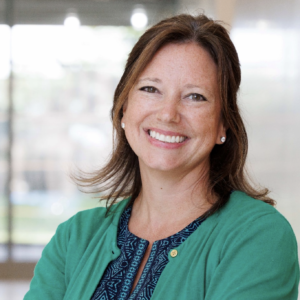
Clare Norton, senior associate dean of enrollment management: “Our professors bring a combination of research-based insights, theoretical frameworks, and practice-based understanding to the classroom”
Clare Norton, Senior Associate Dean of Enrollment Management, COLUMBIA BUSINESS SCHOOL
“At Columbia Business School, we’ve been shaping leaders for over a century. What makes us unique? Well, we blend management fundamentals with data science and real-time business intelligence, giving our students unmatched insights in areas like the digital future, entrepreneurship, finance, climate, and more. Our cutting-edge curriculum keeps evolving with the industry, ensuring you get both core concepts and specialized knowledge. Our professors are top-notch, bringing research-based insights and real-world experience to the classroom. Plus, we’re located in the center of global business and our global alumni network of 50,000+ is out there changing the world.
So, if you want a business school that’s ahead of the curve and focused on your success, Columbia Business School is the place to be.
“Key elements in our teaching of leadership include experiential workshops, personalized coaching, and team-based projects. Additionally, we offer leadership immersion programs and executive mentorship opportunities to enhance students’ competitiveness in the job market. Our courses are taught by award-winning faculty from across disciplines, and our professors bring a combination of research-based insights, theoretical frameworks, and practice-based understanding to the classroom.
Our internationally recognized centers, including the Sanford C. Bernstein & Co. Center for Leadership and Ethics, build on the classroom experience with programs, events, mentorship, networking opportunities, and more.”
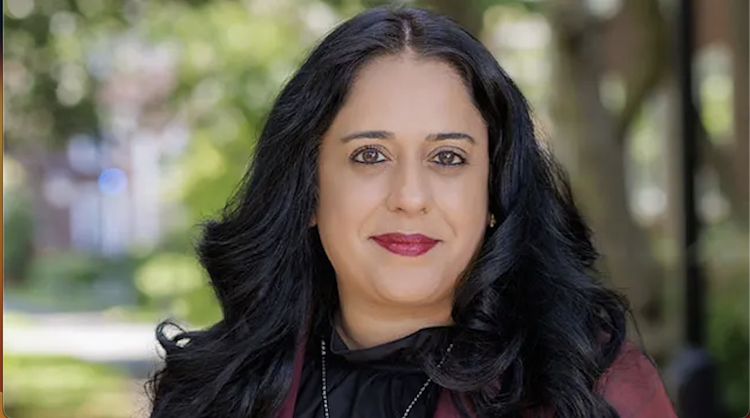
Rupal Gadhia, HBS managing director of MBA admissions and financial aid: “We educate leaders who make a difference in the world”
Rupal Gadhia, Director of MBA Admissions and Financial Aid, HARVARD BUSINESS SCHOOL
“We continue to make a Harvard Business School MBA degree more affordable to a wide range of students. In 2022, we announced that we will provide fellowships covering the total cost of tuition and course fees for 10 percent of our student body—those with the greatest financial need. Additionally, our application fee waiver is now automatically applied to any applicant whose annual income at their current or most recent place of employment is $65,000 USD or less. If one does not automatically qualify, they may still submit a need-based waiver request.
“We also continue to invest in international programming as we believe that today’s business leaders must be ready to work in a global context. As part of the FIELD course, all first-year students travel to one of 15 international locations for 10 days to develop new product or service concepts with local companies. Additionally, in the second-year elective curriculum, students can enroll in an Immersive Field Course (IFC) in the fall, leading up to a 10-14 day immersion during the January term. Locations vary each year based on the IFC portfolio, ranging from Tokyo to Accra to Milan.
“Our mission statement is the foundation of everything we do at HBS: We educate leaders who make a difference in the world. We believe that business can and must play a critical role in addressing today’s unprecedented challenges and opportunities.
“It all starts in the classroom, where our students discuss up to 500 cases over their two years on campus. At HBS, content and community go hand-in-hand. Case method teaching and learning —in all its various forms— is about the respectful debate of ideas. HBS brings together amazingly talented people from diverse backgrounds and puts their experiences front and center. Students do most of the talking (and lots of active listening), and their job is to better understand the decision at hand, what they would do in the case protagonist’s shoes, and why. They leave the class thinking differently about the case than they did coming in. That’s the beauty of the case method. Our powerful learning experience, combined with a residential campus and deeply supportive alumni network, creates a community of bold thinkers and collaborative learners energized to test new ideas and solve problems.
“What I remember most from my experience is how classmates went above and beyond to help one other succeed both in and outside of the classroom. Even today, I continue to be amazed at how connected the alumni network is. Whenever I call on HBS alumni, they still exceed my expectations on how much they are willing to help, even 20 years post-graduation.”
Blair Mannix, Director of MBA Admission, THE WHARTON SCHOOL

Blair Mannix, Wharton director of MBA admissions: “The Wharton experience is fundamentally about choice”
“What sets Wharton apart is the flexibility of the program. The curriculum offers both a business foundation and a ton of freedom to explore new topics. We offer 21 majors and over 200 electives, a variety of course styles like case studies, lectures, and simulations, and students can learn across two campuses in Philadelphia and San Francisco. The Wharton experience is fundamentally about choice, and we love that our students can tailor their experience to meet their unique personal and professional goals.
“Students can study the complex relationships between business and the natural environment through our Business, Energy, Environment, and Sustainability (BEES) major and our Environmental, Social, and Governance Factors for Business (ESGB) major, which are housed under Wharton’s faculty-led ESG Initiative. Additionally, there’s a student-led group called the Wharton Sustainable Business Club (SBC) who are bringing together students interested in addressing global environmental and sustainability issues by increasing related academic and career opportunities on campus.
“Wharton puts a strong emphasis on leadership development and helping students get a deeper understanding of themselves, their organizations, and communities. The McNulty Leadership Program is a research-based program that develops communities and spaces that foster and facilitate leadership learning experiences. The program offers travel opportunities that are physically intense and provide genuine moments of uncertainty and challenge. They also offer on-campus experiences like one-on-one executive coaching. Students can also create their own leadership opportunities outside of the classroom by taking on board roles in student clubs, conferences, and extra-curricular programs.”
Emily Haydon, Assistant Dean of Admissions and Financial Aid, NORTHWESTERN KELLOGG SCHOOL OF MANAGEMENT

Emily Haydon, Kellogg assistant dean of admissions and financial aid: School focuses on “developing a leader that can navigate an environment of change”
“Kellogg is committed to evolving our curriculum and class offerings to give students the necessary opportunities and skills to become the leaders of tomorrow. …
“Kellogg equips students with a unique and special combination of analytical, creative and social intelligence to help them thrive and lead in today’s unpredictable and increasingly complex business environment.
“Confirmed by incoming students every year, our culture of collaboration, inclusivity, and empathy is what truly sets our program apart. We are always looking for students who aren’t afraid to take risks, who want to drive lasting impact for their organizations and communities and who truly embody ‘high-impact, low ego’ leadership.
“The school’s focus is on developing a leader than can navigate an environment of change, and a leader who has been shaped by and embodies the essential quality of creativity and collaboration. With this focus and shared culture, we produce leaders who leverage this empathic mindset to drive relationships and performance both professionally and personally.”
UNDERGRADUATE MAJORS OF THE M7 MBA CLASSES OF 2024 & 2025
Harvard Class of 2025 (Class of 2024) | Wharton Class of 2025 (Class of 2024) | Columbia Class of 2025 (Class of 2024) | Booth Class of 2025 (Class of 2024) | Kellogg Class of 2025 (Class of 2024) | Stanford Class of 2025 (Class of 2024) | MIT Sloan Class of 2025 (Class of 2024) |
Engineering: 25% (28%) | Humanities: 40% (34%) | Business: 35% (37%) | Business: 26% (25%) | Economics/Business: 50% (49%) | Business/Commerce/Econ: 41% (45%) | Engineering: 33% (29%) |
Business/Commerce: 22% (24%) | Business: 27% (32%) | Economics: 20% (18%) | Economics: 20% (25%) | STEM: 38% (35%) | Engineering, Math & Natural Sciences: 41% (38%) | Economics: 18% (17%) |
Economics: 21% (19%) | STEM: 33% (34%) | Engineering: 17% (15%) | Engineering: 25% (24%) | Humanities: 25% (21%) | Humanities, Social Sciences: 18% (24%) | Business: 16% (23%) |
Math/Physical Science: 17% (14%) | Social Sciences: 11% (13%) | Liberal Arts: 14% (13%) | Math & Science: 12% (15%) | |||
Social Sciences: 12% (10%) | Humanities: 6% (6%) | Physical Sciences: 8% (9%) | Social Science: 5% (10%) | |||
Arts/Humanities: 4% (5%) | Sciences: 8% (7%) | Other: 6% (4%) | Other: 6% (1%) | |||
Technology: 2% (2%) | Law 1% (N/A) | Humanities: 3% (2%) | ||||
Other: 1% (N/A) | Computer Science: 6% (2%) | |||||
Law: 1% (1%) |
Source: B-school class profiles
Starr Marcello, Deputy Dean, CHICAGO BOOTH SCHOOL OF BUSINESS
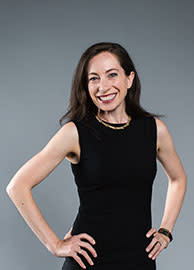
Starr Marcello, Chicago Booth deputy dean: “Flexibility and choice are intentionally built into the program”
“Chicago Booth is the best academic business school in the world. Period. It is a school with the power and potential to transform a student’s life, and with a global community and immense support systems in place to foster student success. The Booth experience is a manifestation of the unique goals and passions of each student—providing countless opportunities to lead effectively and build tight-knit relationships that define our pay-it-forward culture. Flexibility and choice are intentionally built into the program in ways that enhance all parts of the student journey, from communal living in downtown Chicago to recruiting support; from curriculum flexibility to leadership development. Our renowned faculty, including several Nobel Prize winners, combine pathbreaking research and inspirational teaching to shape current and future leaders of the world. Graduates leave with the confidence, connections, and skills to develop groundbreaking ideas and drive meaningful impact throughout every stage of their career.
“As MBA students and future business leaders, graduates will inevitably face decisions around sustainability and social responsibility. Chicago Booth equips students, alumni, organizations, and policymakers with the knowledge and tools to prepare for those challenges. Across numerous areas of study, Booth faculty bring to students—sometimes within the first week of class—their research and scholarly work on subjects such as the importance and benefits of sustainable investing. Additionally, we have created new courses that explore issues of sustainability across several disciplines, including Real Estate and Equity; Navigating the ESG Landscape: Information, Sustainability Reporting, and Analysis; Marketing Strategy (with Sustainability Simulation); Business with Purpose, and our Global Social Entrepreneurship Lab. We also offer lab classes like Corporate Social Responsibility (CSR) Social Impact Practicum, in which students work with corporate clients on sustainability-related projects.”
Paul Oyer, Associate Dean, STANFORD GRADUATE SCHOOL OF BUSINESS

Paul Oyer, Stanford associate dean: School’s culture “fosters teamwork and innovation both inside the classroom and elsewhere at the GSB”
“We believe that what differentiates the GSB is a commitment to training students in the craft of leadership. Our curriculum embeds the core principle that leadership is a craft, one that blends discipline and logic with intuition and feeling. We do not simply aim to transform our students by deepening and broadening their grasp of general management functions and disciplines, although that is critical.
“We also push our students to work on honing the craft of leadership, to balance and integrate reason and imagination, the insights gained from first principles and the lessons won from experience. We strive to amplify students’ existing strengths and give them the opportunity to recognize and develop their relative weaknesses, so that they emerge as more balanced business leaders who are ready to take on the world’s greatest challenges.
“We also believe that the collaborative culture at the GSB is unique. This culture fosters teamwork and innovation both inside the classroom and elsewhere at the GSB. Our students also have close access to world-class faculty and prominent leaders from across the globe through a variety of campus events. Whether in the classroom or at clubs, activities, and beyond – this collaborative spirit establishes strong relationships that persist and evolve well past our students’ time on campus.”
Tara Walor, Assistant Dean of Student Services, MIT SLOAN SCHOOL OF MANAGEMENT
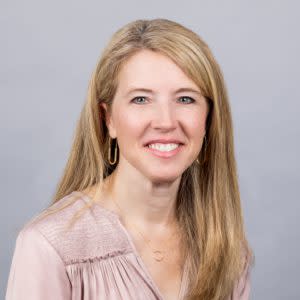
Tara Walor, assistant dean of student services: MIT students “assimilate management theory” and become “intentional about their leadership journey”
“MIT Sloan now offers seven certificate programs in the following areas: Business Analytics, Digital Product Management, Enterprise Management, Entrepreneurship and Innovation, Finance, Healthcare, and Sustainability. The certificates allow students to focus their studies and deep dive into an area of interest. Each certificate program provides foundational knowledge and hands-on industry experience while allowing students to tailor their education, build their network, and meet their professional goals.
“MIT Sloan’s Action Learning embodies MIT’s Mens et Manus (Latin for ‘Mind and Hand’) motto. Students apply their classroom knowledge to real-world business challenges, which equips them with problem-solving skills, adaptability, and a team mindset that they can apply to their own organizations and careers. Students enrolled in Action Learning Labs work with startups, domestic and international corporations, and non-profits located across the globe.
“Throughout this immersive learning experience, students reflect on themselves professionally and personally, both to assimilate management theory and to be intentional about their leadership journey. Most recently, we have introduced our Digital Product Management Lab, Organizations Lab: Leading with Impact, ASEAN Lab, and Alternative Investments Lab to our current portfolio which, each year, includes approximately 20 Labs.”
PRE-MBA INDUSTRIES FOR STUDENTS AT M7 SCHOOLS: 2024-2025
Harvard Class of 2025: 938 students (2024: 1,015) | Wharton Class of 2025: 874 students (2024: 877) | Columbia Class of 2025: 829 students (2024: 864) | Booth Class of 2025: 637 students (2024: 621) | Kellogg Class of 2025: 529 students (2024: 503) | Stanford Class of 2025: 431 students (2024: 424) | MIT Sloan Class of 2025: 409 students (2024: 408) |
Venture Capital/Private Equity: 17% (16%) | Consulting 27% (27%) | Financial Services 29% (31%) | Financial Services 19% (19%) | Consulting 26% (24%) | Consulting 17% (20%) | Consulting 26% (23%) |
Consulting 17% (16%) | PE/VC 14% (9%) | Consulting 21% (22%) | Consulting 18% (25%) | Financial Services 19% (19%) | PE/VC/Investment Banking 19% (20%) | Financial Services 17% (23%) |
Technology 13% (14%) | Other 7% (9%) | Marketing/Media 12% (12%) | Marketing/Media N/A (N/A) | Technology 19% (17%) | Technology 13% (15%) | Technology 23% (14%) |
Finance 10% (10%) | Nonprofit/Government 10% (11%) | Technology 11% (9%) | Technology 15% (13%) | Other 9% (8%) | Government/Education/Nonprofit 10% (8%) | Government/Nonprofit 10% (14%) |
Manufacturing 9% (9%) | Tech/Internet Services 12% (12%) | Other 6% (N/A%) | Other 12% (12%) | Government/Nonprofit 4% (7%) | Consumer Products & Services 9% (7%) | Pharmaceutical/Healthcare/Biotech 7% (6%) |
CPG/Retail 10% (9%) | Financial Services 7% (5%) | Nonprofit 3% (3%) | Nonprofit/Government 14% (11%) | Media/Entertainment 4% (4%) | Media/Entertainment 4% (5%) | Other 7% (7%) |
Healthcare/Biotech 7% (8%) | Healthcare 5% (5%) | Healthcare 5% (5%) | Healthcare 7% (6%) | Consumer Goods 5% (7%) | Healthcare 7% (5%) | Energy 2% (4%) |
Nonprofit/Government 6% (6%) | CPG/Retail 3% (2%) | Real Estate 5% (7%) | Real Estate N/A (N/A) | Health/Bio 8% (7%) | Financial Services 5% (4%) | Manufacturing 3% (3%) |
Military 6% (4%) | Energy 1% (2%) | Military/Government 5% (4%) | Military 11% (11%) | Manufacturing 3% (2%) | Clean Tech/Energy/Environmental 4% (3%) | Consumer Products/Retail 2% (3%) |
Services 2% (3%) | Media/Entertainment 1% (2%) | Energy 2% (1%) | Energy 2% (4%) | Military 3% (4%) | Military 5% (4%) | Automotive/Transportation/Defense 2% (2%) |
Media/Entertainment 3% (4%) | Investment Banking/Management 12% (N/A) | Manufacturing N/A (1%) | PE/VC 7% (5%) | Energy 1% (2%) | Manufacturing 3% (3%) | Media/Entertainment/Sports 1% (0.5%) |
Manufacturing 2% (N/A) | Other 1% (N/A) | |||||
Consumer Products 3% (N/A) | ||||||
Accounting 1% (N/A) |
Source: B-school class profiles
See the next page for the M7’s place in the various rankings.
AND DON’T MISS POETS&QUANTS COVERAGE OF M7 MBA CLASS OF 2025 PROFILES
STANFORD’S MBA CLASS OF 2025 IS ONCE AGAIN AMONG THE MOST DIVERSE IN THE WORLD
WHARTON MBA CLASS OF 2025: APPS FALL AGAIN, BUT PENN REACHES PARITY FOR A 3RD STRAIGHT YEAR
HARVARD MBA CLASS OF 2025 ACHIEVES SCHOOL’S FIRST GMAT INCREASE IN 13 YEARS
MBA CLASS OF 2025: WHAT IT TOOK TO GET INTO THIS NO. 1-RANKED B-SCHOOL
MIT SLOAN MBA CLASS OF 2025: SLOAN STAVES OFF SERIOUS APPLICATION SLIDE
KELLOGG MBA CLASS OF 2025: NEAR-RECORDS FOR GMAT, INTERNATIONAL & WOMEN’S ENROLLMENT
MBA APPS TO COLUMBIA WERE DOWN BIG AGAIN IN 2022-2023
POETS&QUANTS’ MEET THE CLASS SERIES: M7 CLASS OF 2025
MEET COLUMBIA BUSINESS SCHOOL’S MBA CLASS OF 2025
MEET HARVARD BUSINESS SCHOOL’S MBA CLASS OF 2025
MEET STANFORD GSB’S MBA CLASS OF 2025
MEET NORTHWESTERN KELLOGG’S MBA CLASS OF 2025
MEET MIT SLOAN’S MBA CLASS OF 2025
MEET WHARTON’S MBA CLASS OF 2025
MEET CHICAGO BOOTH’S MBA CLASS OF 2025

Business school rankings have been in a major slump since the onset of the coronavirus pandemic. Both Bloomberg Businessweek and The Economist were hammered for methodological miscues in 2022, leading to the latter’s declaration that it has left the rankings game altogether; the former might want to consider a similar route, given the lingering dark cloud over its methodology. Forbes hasn’t bothered to do a ranking since 2019, and it’s increasingly unlikely that it ever will again.
THE M7 IN THE RANKINGS
Current Rankings | Harvard | Wharton | Columbia | Booth | Kellogg | Stanford | MIT |
Poets&Quants | 2 (5) | 31 (1) | 4 (7) | 11 (2) | 12 (4) | 1 (3) | 14 (6) |
U.S. News | 6 (5) | 1T (3) | 12T (11) | 3T (1) | 3T (2) | 1T (6T) | 5 (4) |
Businessweek 2023 (2022) | 6 (2T) | 8 (7) | 5 (8) | 2 (2T) | 7 (4) | 1 (1) | 10T (6) |
Financial Times | 11 (4T) | 1 (NR) | 3T (1) | 10 (11T) | 6T (9) | 23 (4T) | 6T (11T) |
Economist 2022 | 1 | 2 | 4 | 9 | 3 | 8 | 5 |
Forbes 2019 (2017) | 4 (3) | 5 (1) | 7 (6) | 1 (7) | 3 (4) | 2 (2) | 7 (8) |
Source: Current rankings
One of the remaining ranking outlets, The Financial Times, is all over the place since the top schools — including the M7 — boycotted their 2020 list; its 2023 list notoriously excluded Wharton, which had been No. 1 the previous year. (Wharton returned to the top of the FT list in 2024.) Then there are the bogus rankings from Fortune, CEOWorld, and QS, which hardly merit mention. Even U.S. News was dinged in 2023 for a messy ranking that had to be delayed to iron out major issues. (The magazine’s response was to make big changes in its 2024 list, resulting in praise from B-school deans.)
U.S. NEWS & FINANCIAL TIMES ASSESSMENT SCORES FOR THE M7
Assessment Scores 2024 (2023) | Harvard | Wharton | Columbia | Booth | Kellogg | Stanford | MIT |
U.S. News Recruiter Assessment Score (out of 5) | 4.6 (4.6) | 4.5 (4.5) | 4.2 (4.2) | 4.6 (4.6) | 4.5 (4.5) | 4.7 (4.7) | 4.6 (4.5) |
U.S. News Peer Assessment Score (out of 5) | 4.7 (4.8) | 4.6 (4.7) | 4.4 (4.4) | 4.6 (4.7) | 4.5 (4.5) | 4.7 (4.8) | 4.6 (4.6) |
Financial Times’ Aims Achieved | 90% (91%) | 89% (N/A) | 89% (91%) | 90% (91%) | 90% (90%) | 94% (93%) | 89% (91%) |
Financial Times‘ Research Rank | 2 (1) | 1 (N/A) | 4 (2) | 2 (4) | 14 (9) | 13 (7) | 21 (13) |
Financial Times’ Salary Increase | 112% (117%) | 121% (N/A) | 127% (132%) | 126% (123%) | 125% (122%) | 117% (131%) | 130% (111%) |
Source: U.S. News & Financial Times
Looking for a consistent and widely respected ranking? Your best bet is Poets&Quants’ annual aggregate list. Yet even P&Q has its detractors. Our 2024 list reflects the topsy-turvy nature of the rankings game: For the first time this year, one of the M7 — Wharton — fell out of the top 25, and three others — Chicago Booth, Northwestern Kellogg, and MIT Sloan — dropped out of the top 10. It’s a measure of the importance of the M7 that when they don’t do well in a particular ranking, questions are aimed not at the schools themselves but at the rankings and those managing them. After all, if an M7 school is down-voted, there must be something amiss with the vote, not the illustrious school, right?
U.S. NEWS SPECIALIZATION RANKINGS FOR THE M7, 2022-2024
U.S. News Rankings by Specialization 2024 (2023, 2022) | Harvard | Wharton | Columbia | Booth | Kellogg | Stanford | MIT |
Accounting | 15 (13T, 14T) | 2 (2, 2) | 22T (29T, 20T) | 6 (6, 4) | NR (29T, 26T) | 7 (8, 9T) | 22T (26T, 18) |
Entrepreneurship | 5 (4, 6) | 8T (6, 6) | 26T (NR, 27T) | 16T (23T, 27T) | 26T (NR, 19T) | 2 (2, 2) | 3 (3, 3) |
Finance | 7 (7, 7) | 1 (1, 1) | 4 (4, 4) | 2 (2, 2) | 15 (14T, 18) | 5 (6, 6) | 6 (5, 5) |
Management | 1 (1, 1) | 5T (5, 7) | 12 (12, 11) | 15 (19, 21) | 5T (4, 3T) | 3 (2, 2) | 13 (16T, 14T) |
Information Systems | NR (NR, NR) | NR (9T, 9T) | NR (NR, NR) | NR (NR, NR) | NR (NR, NR) | NR (NR, NR) | 1 (2, 1) |
Marketing | 8 (7, 6) | 2 (2, 2) | 6 (5, 7) | 7 (6, 8) | 1 (1, 1) | 4T (4, 3T) | NR (31T, NR) |
Production & Operations | 13T (12T, 11T) | 6 (7, 8) | 11T (17, 11T) | 18T (19T, 23T) | 13T (12T, 15) | 5 (4, 5) | 1 (1, 1) |
Nonprofit | 2 (2, 2) | NR (NR, NR) | 6 (6, 7) | 9 (8T, 9T) | 8 (NR, 9T) | 3 (3, 3) | NR (NR, NR) |
Supply Chain Logistics | NR (NR, NR) | 14T (15, 17T) | 21T (NR, NR) | NR (25T, NR) | 13 (13, 17T) | 10T (9T, 10) | 2 (2, 2) |
International Business | 3T (2, 2) | 3T (6, 7) | 5 (5, 6) | NR (NR, NR) | NR (NR, 23T) | NR (NR, NR) | 21 (15, 17T) |
Business Analytics | 12 (11, 10T) | 3 (4, 3T) | 6 (8, 12) | 8T (9, 8) | 25T (16T, 17) | NR (NR, NR) | 1 (1, 1) |
Project Management | NR (NR, NR) | NR (NR, NR) | NR (NR, NR) | NR (NR, NR) | NR (NR, NR) | NR (NR, NR) | 1T (1, 1) |
Real Estate | NR (NR, NR) | 1 (1, 1) | 2T (3, 4) | NR (NR, NR) | 13 (11T, 12T) | NR (NR, NR) | 10 (11T, 12T) |
Source: U.S. News
CHECK OUT POETS&QUANTS’ COVERAGE OF THE M7 IN THE MBA RANKINGS:
POETS&QUANTS’ 2023-2024 RANKING: STANFORD’S TRIUMPHANT RETURN TO THE TOP
STANFORD & WHARTON TIE FOR FIRST IN U.S. NEWS’ 2024 MBA RANKING
FINANCIAL TIMES 2024 MBA RANKING: WHARTON RETURNS TO THE TOP, HARVARD & STANFORD PLUNGE TO NEW LOWS
HOW U.S. NEWS RANKS THE TOP U.S. B-SCHOOLS BY MBA SPECIALIZATION
THE ABSOLUTE WORST MBA RANKINGS
HARVARD & WHARTON SLUMP IN NEW 2023 BUSINESSWEEK MBA RANKING
AND SEE THE SCHOOLS’ OWN CLASS OF 2023 EMPLOYMENT REPORTS HERE:
THE WHARTON SCHOOL AT THE UNIVERSITY OF PENNSYLVANIA
CHICAGO BOOTH SCHOOL OF BUSINESS
NORTHWESTERN KELLOGG SCHOOL OF MANAGEMENT
STANFORD GRADUATE SCHOOL OF BUSINESS
MIT SLOAN SCHOOL OF MANAGEMENT
The post The M7 By The Numbers: What It Takes To Get In & What It Means For Your Career appeared first on Poets&Quants.

 Yahoo Finance
Yahoo Finance